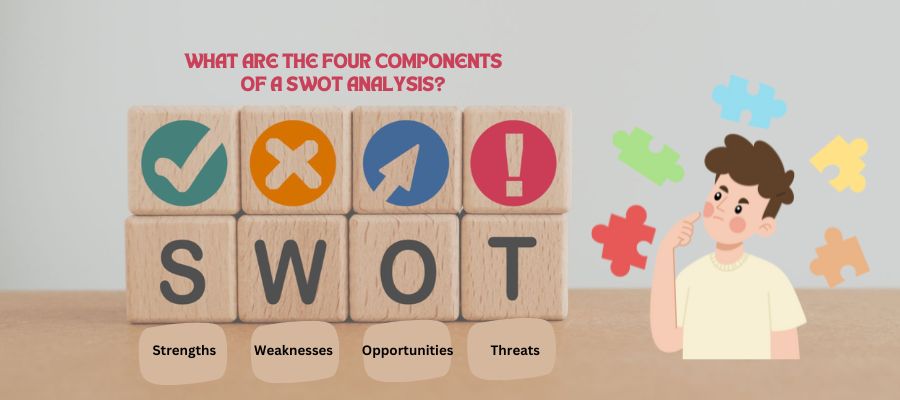SWOT Analysis is a strategic planning tool used to evaluate an organisation’s Strengths, Weaknesses, Opportunities, and Threats. It provides a comprehensive framework for understanding both internal and external factors that influence a business. By performing a SWOT analysis, businesses can make more informed decisions and develop strategies to achieve their goals effectively.
This analysis aids in aligning business objectives with the competitive landscape and internal capabilities. It helps organisations identify areas for improvement and capitalise on potential growth opportunities.
Importance of SWOT Analysis in Strategic Planning
SWOT analysis is a valuable tool in the strategic planning process. It ensures that an organisation considers both internal and external factors while formulating its strategies. By understanding internal strengths and weaknesses and external opportunities and threats, businesses can:
- Identify critical areas for growth or improvement.
- Develop strategies to capitalise on strengths and external opportunities.
- Address weaknesses to avoid potential threats.
- Make informed decisions that align with long-term goals.
Using SWOT analysis ensures that organisations remain proactive in a dynamic business environment.
What Are the Four Components of a SWOT Analysis?
The four components of SWOT analysis are Strengths, Weaknesses, Opportunities, and Threats. Each component plays a critical role in providing a comprehensive understanding of the organisation:
- Strengths: Internal attributes that provide a competitive advantage.
- Weaknesses: Internal factors that could hinder performance.
- Opportunities: External factors that offer potential growth.
- Threats: External elements that pose challenges.
These four components of a SWOT analysis form the foundation for decision-making and strategic planning.
1. Strengths
A. Definition and Significance of Strengths
Strengths refer to the internal factors that give a business a competitive edge in the market. These are resources or capabilities that the organisation excels in, such as a strong brand, an extensive customer base, or financial stability.
Understanding strengths helps businesses focus on areas where they have an advantage, ensuring sustained growth and market share retention.
B. Identifying Internal Strengths of an Organisation
Internal strengths can be identified by assessing the following:
- Brand Recognition: Does the business have a well-known brand?
- Customer Loyalty: Is there a strong and dedicated customer base?
- Resources: Are financial and human resources adequately available?
- Operational Efficiency: Are processes streamlined?
C. Examples of Common Strengths in Businesses
- Strong brand recognition.
- Robust financial resources.
- Skilled and experienced workforce.
- Innovative products or services.
- Efficient supply chain management.
2. Weaknesses
A. Definition and Significance of Weaknesses
Weaknesses are internal factors that hinder an organisation’s performance or competitiveness. Recognising weaknesses allows businesses to address areas where they need improvement.
B. Identifying Internal Weaknesses of an Organisation
To identify weaknesses:
- Analyse areas with poor performance.
- Evaluate employee skill gaps.
- Assess outdated or inefficient processes.
- Examine customer feedback for recurring issues.
C. Examples of Common Weaknesses in Businesses
- Limited financial resources.
- Low brand awareness in the market.
- Inefficient processes or outdated technology.
- Weak online presence or marketing strategy.
3. Opportunities
A. Definition and Significance of Opportunities
Opportunities refer to external factors that a business can leverage to achieve growth. They can arise from new market trends, technological advancements, or changes in the business environment.
B. Identifying External Opportunities in the Market
Organisations can identify opportunities by:
- Analysing market trends and customer demands.
- Monitoring competitors for gaps in offerings.
- Keeping an eye on emerging technologies.
- Exploring untapped geographical regions.
C. Examples of Potential Opportunities for Growth
- Expanding into a new market.
- Launching innovative products.
- Forming strategic partnerships.
- Capitalising on shifts in consumer behaviour.
4. Threats
A. Definition and Significance of Threats
Threats are external factors that pose risks to the business. Identifying threats helps organisations prepare and develop strategies to mitigate them.
B. Identifying External Threats to an Organisation
To identify threats:
- Evaluate external factors that could impact operations, such as regulations or economic downturns.
- Analyse competitors’ strategies.
- Monitor technological disruptions.
- Assess vulnerabilities in the supply chain.
C. Examples of Common Threats Faced by Businesses
- Economic downturns affecting revenue.
- Increased competition in the market.
- Changes in regulations or policies.
- Technological advancements by competitors.
Conclusion
SWOT Analysis is a strategic planning tool that enables organisations to gain a deeper understanding of their position in the market. By analysing the elements of swot like strengths, weaknesses, opportunities, and threats, businesses can make informed decisions and develop strategies to address challenges. This comprehensive approach helps in achieving long-term goals and maintaining a competitive edge.
FAQs
1. What are the 4 components of a SWOT analysis?
The four components are Strengths, Weaknesses, Opportunities, and Threats. These form the foundation for strategic decision-making.
2. What do the 4 P’s stand for?
The 4 P’s refer to Product, Price, Place, and Promotion in marketing strategies.
3. How Do I Integrate SWOT Analysis into Strategic Planning?
To integrate SWOT analysis, align your business strategies with the insights gained from analysing strengths, weaknesses, opportunities, and threats.
4. How Do You Write a Good SWOT Analysis?
Conduct a thorough assessment of internal and external factors, use clear headings, and provide actionable insights for each component.
5. What Is the Best Time to Perform a SWOT Analysis?
Perform a SWOT analysis when launching a new product, entering a new market, or during major organisational changes.
Also Read: What Are the Four Parts of a Swot Analysis?





